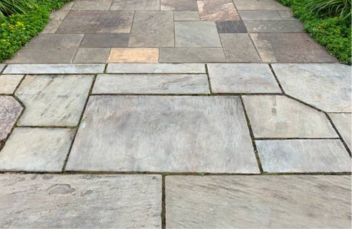The Right Way to Care for Your Bluestone Patio

A bluestone patio brings a classic look to your backyard and, when cared for properly, it can last for decades. The trick is knowing how to clean it, protect it, and maintain it through every season.
Many homeowners make the mistake of treating stone like concrete, but bluestone has its own needs. With the right care, you can keep it looking sharp and safe for family and guests.
Let’s walk through the best way to maintain your bluestone patio from week to week and year to year.
Start With Regular Cleaning
Every patio begins with simple upkeep. A quick sweep every week will go a long way toward protecting the stone. Leaves, dirt, and small sticks may not seem like much, but when they pile up, they hold moisture and cause stains. Use a stiff broom or even a leaf blower to clear off debris.
Once you’ve swept the surface, hose it down with plain water. That light rinse removes dust and prevents grime from building up in the stone’s pores.
For tougher dirt, fill a bucket with warm water and a mild soap that’s pH neutral. Use a soft-bristled brush to scrub the area, then make sure to rinse it well.
Avoid acidic or harsh cleaners. Those can wear away at the stone's surface, making it look dull.
Act Fast on Spills and Stains
Spills happen, especially when you’re cooking or serving drinks outdoors. Don’t let them sit. Because bluestone is porous, water can soak in and leave a dark mark. The best move is to blot the spill right away with a cloth, then wash the spot with your soap solution and rinse thoroughly.
If a food or drink stain does set in, mix baking soda with water until it forms a paste. Spread it over the spot and let it sit for about fifteen minutes. Scrub gently with your brush and rinse clean.
For oil stains, you may need a poultice designed for natural stone, which can draw the oil out of the surface.
Sealing Protects the Stone
Sealing your bluestone patio every two years is one of the best ways to make it last longer. A quality sealer will protect against stains, fading, and moisture damage. Make sure the stone is clean and dry before you seal it. Any dirt or dampness trapped under sealer will stay there until the coating wears off.
Use a paint roller or yard sprayer to spread the sealer out evenly. Work slowly so you don’t miss spots and wipe up any puddles that form.
Some homeowners like a sealer that leaves a natural look, while others prefer one that enhances the color and adds a slight sheen. Either way, a good sealer acts like a shield against the elements.
Watch for Cracks and Loose Stones
Over time, even the best patios can develop small cracks or chips. Check the surface regularly, especially after winter, when freezing and thawing can put stress on the stone.
Minor cracks can often be repaired with a resin or epoxy filler made for stone. Larger damage mayrequire professional help. Addressing these issues quickly prevents them from spreading and keeps the patio safe to walk on.
If your patio has stones set in sand or gravel, check the joints. Weeds and erosion can loosen them. Reseating a stone before it becomes a tripping hazard is always easier than fixing a large section later.
Keep the Joints Tight
The joints between your bluestones are just as important as the stones themselves. When weeds or moss start growing between them, they can push stones apart and weaken the surface.
Pull weeds early before their roots spread. For longer-term results, sweep polymeric sand into the gaps and wet it lightly so it hardens. This locks the stones in place, prevents shifting, and discourages new weeds.
Seasonal Maintenance Matters
Your bluestone patio needs a little different care as the seasons change. In spring, wash away the dirt and debris that winter left behind.
In summer, keep up with sweeping, rinsing, and stain control so the stone doesn’t absorb food or drink spills.
Fall brings leaves, which should be cleared quickly to avoid tannin stains that can be tough to remove.
Winter requires the most caution. Never use rock salt or chemical de-icers meant for asphalt or concrete. They can damage natural stone. Instead, spread sand for traction and use a plastic shovel to clear snow.
Metal shovels can scratch or chip the surface. If you keep the patio clear of heavy snow, freeze-thaw damage is less likely to happen.
Manage Water Around the Patio
One of the worst things that can happen to stone is water. It can seep into the base and weaken it if it pools on the patio or around the edges. Over time, that leads to shifting stones, cracks, or surface damage.
Make sure your patio is slightly sloped so rainwater drains away. In problem areas, consider adding a French drain or gravel trench to carry water off.
Keep It Looking Good for Years
Caring for a bluestone patio isn’t complicated, but it does require attention. Sweep it weekly, wash it with gentle cleaners, seal it regularly, and keep an eye out for damage.
Take the seasons into account and protect it from snow, ice, and standing water.Fix things as soon as you notice them, before they get worse.
With this kind of routine, your bluestone patio will remain a solid, attractive feature of your home. You’ll enjoy it for cookouts, family gatherings, or quiet evenings outdoors without worrying about loose stones, stains, or fading. A little care now means decades of durability and beauty later.
